Saltwater Fish Details
Quick Links
Almaco Jack | American Shad | Atlantic Sharpnose Shark | Atlantic Croaker | Banded Rudderfish | Bank Sea Bass | Black Grouper | Black Sea Bass | Black Drum | Blackfin Snapper | Blue Runner | Blue Marlin | Bluefish | Bonefish | Bonnethead Shark | Cero | Cobia | Common Snook | Crevalle Jack | Cubera Snapper | Dog Snapper | Dolphin | Fantail Mullet | Fat Snook | Florida Pompano | Gag Grouper | Goliath Grouper | Gray Snapper | Greater Amberjack | Gulf Flounder | King Mackerel | Ladyfish | Lane Snapper | Lesser Amberjack | Longbill Spearfish | Mahogany Snapper | Mutton Snapper | Nassau Grouper | Palometa | Permit | Queen Snapper | Red Drum | Red Grouper | Red Snapper | Rock Sea Bass | Sailfish | Sand Seatrout | Sandbar Shark | Scalloped Hammerhead | Scamp | Schoolmaster | Sheepshead | Shortfin Mako | Silk Snapper | Silver Seatrout | Silver Perch | Spanish Mackerel | Spotted Seatrout | Striped (Black) Mullet | Swordfish | Swordspine Snook | Tarpon Snook | Tarpon | Vermillion Snapper | Weakfish | White Marlin | White Grunt | Yellowfin Grouper | Yellowmouth Grouper | Yellowtail Snapper
Almaco Jack
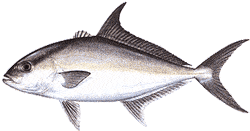
A deep-bodied amberjack; sometimes darker in coloration; front of soft dorsal and of anal fins high and elongated; body more flattened than banded rudderfish or greater amberjack; no scutes.
Where Found:
Wide-ranging in OFFSHORE waters, not a common catch; young are associated with Sargassum.
Size:
Usually less than 20 pounds.
Remarks:
Spawns offshore, apparently during spring, summer, and fall.
American Shad

Color of back green or greenish blue with metallic lustre; silvery sides, white underneath 9 colors darken when fish enters fresh water to spawn); belly with scutes forming distinct keel; one or more dark spots in a row behind operculum; lower jaw with pointed tip that fits into v-shaped notch in upper jaw.
Where Found:
OFFSHORE except during late winter spawning run into east coast rivers, notably the St. Johns River.
Size:
Most catches 2 to 3 pounds; common to 5 pounds
Remarks:
Anadromous species, coming into fresh water to spawn; young remain in fresh water to length of 2 to 4 inches, then move out to sea; plankton feeder, but strikes small, bright spoons or flies; their roe ( as many as 30,000 in a single female ) is prized, the flesh full of fork bones.
Atlantic Sharpnose Shark

Long and flattened snout; white trailing edge of pectoral; black-edged dorsal and caudal fins, especially when young; may have small whitish spots on sides; furrows in lips at the corners of the mouth; outer margin of teeth notched; second dorsal fin originates over middle of anal fin; brown to olive-gray in color with white inderside; slender body.
Where Found:
INSHORE species, even found in surf; also common in bays and estuaries; adults occur OFFSHORE.
Size:
A small species, 2 – 4 feet.
Remarks:
Mature adults between 2 and 2.75 feet long; 4-7 newborns range from 9 to 14 inches in length; adults feed on small fish and crustaceans.
Atlantic Croaker
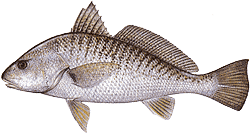
Inferior mouth; 3 to 5 pairs of small barbels on chin; silvery-gray or bronze body with dark oblique wavy bars or lines; iridescent especially on head; preopercle strongly serrated.
Where Found:
Generally found north of Tampa Bay on the west coast, and north of Cape Canaveral on the east coast; young fish found in estuaries; older fish (2 to 3 years) inhabit deep OFFSHORE waters during the winter months and move into bays and estuaries during the spring, summer, and fall.
Size:
Usually less than 2 pounds.
Remarks:
During spawning becomes bronze or yellow in color; spawning apparently occurs OFFSHORE in fall; longevity 2 to 4 years.
Atlantic Spadefish
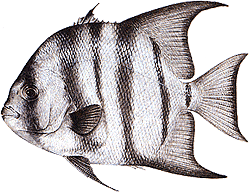
Silvery with 4 to 6 black vertical bands on each side which sometimes become obscure in larger fish; deep, flattened body; separated first and second dorsal fins; concave caudal fin; anterior rays of second dorsal fin and anal fin elongated.
Where Found:
INSHORE and NEARSHORE, around natural reefs, and especially near navigation markers in 15 to 20 feet of water.
Size:
Most catches less than 2 pounds, known to reach 15 pounds.
Remarks:
Spawns in spring and summer; travels in large schools; small juveniles almost totally black, known to drift on their sides and mimic floating debris; feeds on crustaceans, small encrusting invertebrates, and may nibble on tentacles of jellyfish.
Banded Rudderfish
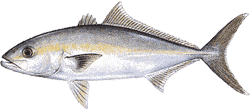
Fish is less than 11 inches long; has dark band from eye to first dorsal fin and six prominent bars on body; larger fish are bluish, greenish, or brown; soft dorsal base about twice the length of the anal fin; tail-lobe white tipped.
Where Found:
NEARSHORE and OFFSHORE over hard bottom, generally in shallower water than other amberjacks; young associated with weed lines or floating debris and may follow shark and other large fish.
Size:
Usually less than 10 pounds.
Remarks:
Adults feed on fish and shrimp; spawns OFFSHORE most of the year.
Bank Sea Bass

Pale olive or brassy brown in color with indistinct black blotches that form vertical barrings ( the blotch above pectoral fin darker ); wavy blue lines on head; lips purplish-blue; caudal fin tri-lobed on adults; edge of nape unscaled.
Where Found:
OFFSHORE in deep water with rocks and reefs.
Size:
Usually 0.3 pounds ( 8 inches).
Remarks:
Undergoes sex change, starting life as a female, changing into male after 3 or 4 spawning seasons; feeds on the bottom, taking squid, crustaceans, and small fish.
Black Grouper

Olive or gray body coloration with black blotches and brassy spots; gently rounded preopercle. OFFSHORE species; adults associated with rocky bottoms. reef, and drop-off walls in water over 60 feet deep; young may occur INSHORE in shallow water.
Where Found:
OFFSHORE species; adults associated with rocky bottoms. reef, and drop-off walls in water over 60 feet deep; young may occur INSHORE in shallow water.
Size:
Common to 40 pounds, may attain weights exceeding 100 pounds. No Florida record because of identity confusion with Gag, which are mistakenly called “Black Grouper”.
Remarks:
Spawns between May and August; protogynous hermaphrodites, young predominantly female, transforming into males as they grow older; larger individuals generally in greater depths; feeds on fish and squid.
Black Sea Bass
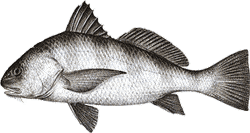
High arched back; 10 to 14 pairs of chin barbels; gray or black colored body in adults; young have 4 to 6 vertical bars; has cobblestone-like teeth capable of crushing oysters; large scales.
Where Found:
Structure-loving fish, associated with reefs and rubble OFFSHORE; smaller specimens often found in INSHORE finger channels.
Size:
Common to 1.5 Pounds ( 13 inches ).
Remarks:
Spawns January through March; protogynous hermaphrodites, older females becoming breeding males; omnivorous bottom feeders, diet including small fish, crustaceans, and shellfish.
Black Drum

High arched back; 10 to 14 pairs of chin barbels; gray or black colored body in adults; young have 4 to 6 vertical bars; has cobblestone-like teeth capable of crushing oysters; large scales.
Where Found:
INSHORE fish common to bays and lagoons; bottom dweller often found around oyster beds; also OFFSHORE.
Size:
Common to 30 pounds.
Remarks:
INSHORE fish common to bays and lagoons; bottom dweller often found around oyster beds; also OFFSHORE.
Blackfin Snapper
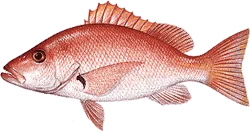
Color generally red, with yellow caudal, anal, and pelvic fins; distinctive and prominent dark comma-shapped blotch at the base of the pectoral fins; which gives the fish its common name; anal fin rounded; no black spot on side underneath dorsal fin.
Where Found:
Adults OFFSHORE near cintinental shelf.
Size:
Common to 20 inches, larger individuals seeking deeper waters.
Remarks:
Sometimes marketed as red snapper; feeds on smaller fish.
Blue Runner
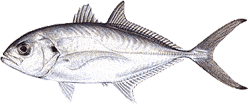
Color light olive to bluish green above, silvery gray to golden below; frequently black spot on operculum; readily distinguished from Crevalle Jack by lack of dark blotch on pectoral fin; tail tips blackish.
Where Found:
Juveniles found OFFSHORE; adults NEARSHORE in schools, but sometimes ranging INSHORE as well.
Size:
Usually less than 1 pound (11 inches).
Remarks:
Matures by 9 to 10 inches; spawns OFFSHORE from January through August; young form schools associated with floating objects, and have been observed living inside the bell of jellyfish; adults feed on fish, shrimp, and squid.
Blue Marlin

Color cobalt blue on top shading to silvery white on bottom; upper jaw elongated in form of spear; dorsal fin and pointed at front end; pectoral fin and anal fin pointed; lateral line reticulated (interwoven like a net), difficult to see in large specimens; no dark spots on dorsal fin; body covered with imbedded scales ending in one or two sharp points.
Where Found:
OFFSHORE, a blue water fish
Size:
Largest of the Atlantic marlins, common to 11 feet, known to exceed 2,000 pounds.
Remarks:
All of trophy size are females; males do not exceed 300 pounds; make trans-Atlantic migration; spawning procedures unknown; feeds on squid and pelagic fish, including blackfin tuna and frigate mackerel.
Bluefish

Color blue or greenish-blue on back, sides silvery; mouth large; teeth prominent, sharp. and compressed; dorsal and anal fins nearly the same size; scales small; lateral line almost straight.
Where Found:
Young usually INSHORE spring and summer; moving OFFSHORE to join adults fall and winter; strong migration of northeast Atlantic stock to Florida east coast in winter.
Size:
Most west coast catches under 3 pounds, much larger on east coast.
Remarks:
Travels in large schools, following schools of baitfish; cannibalistic; all members of a given school about the same size; spawning occurs OFFSHORE in spring and summer.
Bonefish
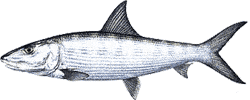
Silvery color with bluish or greenish back; slender, round body; snout long, conical, aiming downward and overhanging lower jaw; dark streaks between scales on upper half of body and faint crossbands extending down to lateral line; extremities of dorsal and caudal fins shaded with black.
Where Found:
Primarily INSHORE fish inhabiting shallows of the Florida Keys; found in shallows often less than 1 foot deep, usually over lush grass flats, occasionally over white sand.
Size:
3 to 5 pounds.
Remarks:
Travels in loose schools; roots out shrimp, shellfish, crabs, and fish from the bottom; spawns offshore, eggs hatching into ribbon-like larvae that metamorphose into fish-like form at about 2 inches and move inshore.
Bonnethead Shark
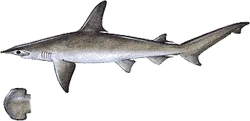
Broadly widened head in the shape of a shovel; only slight indentation of anal fin; front of head not notched at midline; gray or grayish-brown in color.
Where Found:
INSHORE species found in bays and estuaries.
Size:
Commonly 3 to 4 feet.
Remarks:
Matures at about 3 feet in length and bears 6 to 12 young at one time. Feeds chiefly on crabs and other crustaceans.
Cero

Color of black iridescent bluish green; sides silvery; yellow spots forming lines above and below a bronze stripe from pectoral fin to base of the tail; front of first dorsal is bluish black; lateral line curves gradually to base of caudal fin.
Where Found:
NEARSHORE and OFFSHORE fish occurring mainly in south Florida, especially over coral reefs and wrecks.
Size:
Common to 5 pounds.
Remarks:
Unlike other mackerel, does not stray far from Florida waters; spawns OFFSHORE in midsummer; feeds on small fish and squid.
Cobia

Long, slim fish with broad depressed head; lower jaw projects passed upper jaw; dark lateral stripe extends through eye to tail; first dorsal fin comprised of 7 to 9 free spines; when young, has conspicuous alternating black and white horizontal stripes.
Where Found:
Both INSHORE and OFFSHORE inhabiting inlets, bays, and among mangroves; frequently seen around buoys, pilings and wreaks.
Size:
Common to 30 pounds.
Remarks:
Spawns in spring and early summer; feeds on crabs, squid, and small fish.
